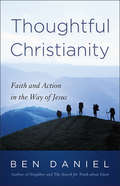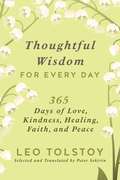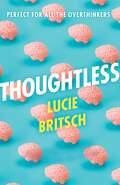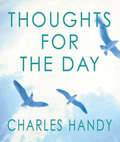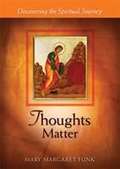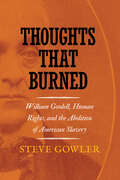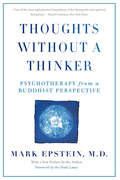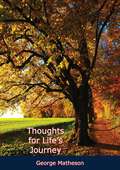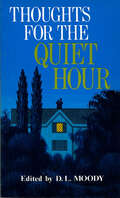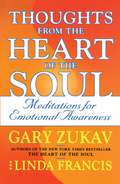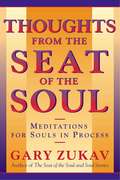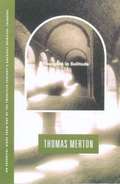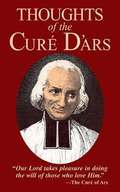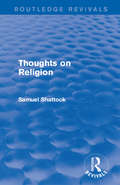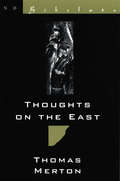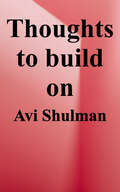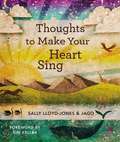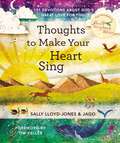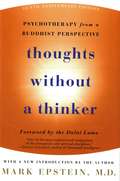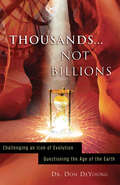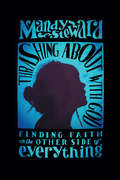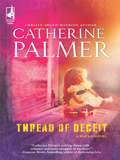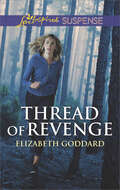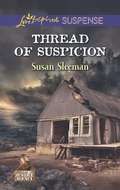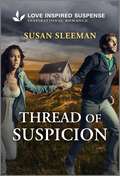- Table View
- List View
Thoughtful Christianity
by Ben Daniel"The next revival must be an awakening in the intellect of Christians ready to mark the life of the church and of the broader society with a thoughtful faith. " Thoughtful Christianity provides a guide to Christian faith that honors tradition while embracing modern thought and valuing critical reflection. Daniel examines the extreme polarization of Christianity in the last century and argues that American Christians are in need of an awakening of the mind. He suggests a way of life that includes commitment to education, high value placed on curiosity, and instruction from "those with the courage to be corrected. " Divided into three parts, the book explores how science can inform faith, the marks of a thoughtful life, and some suggestions for living a thoughtful life. Daniel shows us how we can move forward, unbound by labels, to know and serve God better.
Thoughtful Wisdom for Every Day: 365 Days of Love, Kindness, Healing, Faith, and Peace
by Leo TolstoyInspirational Wisdom for Every Day in a Classic Daybook—"An excellent gift . . . A fine inspirational" (Midwest Book Review) During the last years of his life, Leo Tolstoy kept one book invariably on his desk, read and reread it to his family, and recommended it to all his friends: a compendium of wise thoughts gathered over the course of a decade from his wide‑ranging readings in philosophy and religion, and from his own spiritual meditations. Thoughtful Wisdom for Every Day comprises Tolstoy&’s own most essential ideas about spirituality and what it is to live a good life. Designed to be a cycle of daily readings, this book offers thoughts and aphorisms for every day, following a succession of themes repeated each month—such as God, the soul, desire, faith, our passions, humility, inequality, evil, truth, happiness, and the blessings of love. Comforting, challenging, and inspiring, this is a spiritual treasure trove and a book of great warmth.
Thoughtless: A sharp, profound and hilarious new novel - for all the overthinkers...
by Lucie Britsch"No one understands the misery and hilarity of being alive better than Lucie Britsch ... Writing like this takes talent and the most tender of hearts." JEAN KYOUNG FRAZIER, author of PIZZA GIRLAll her life, Susan's loved ones have been hiding a terrible secret from her: If she thinks too hard, her head will explode. Luckily, her devoted boyfriend, anxious parents and fierce best friend are prepared to do whatever it takes to keep Susan safe in ignorant, thoughtless bliss. And until now, Susan has lived happily in a bubble of TV and takeaways, social media and small talk; anything to distract her from the spiralling thoughts that so often haunt the rest of us - thoughts that would be deadly for her. But what happens when reality creeps in and Susan's perfectly curated world starts to crumble? Can we distract ourselves from the real world forever... and should we?Praise for Lucie Britsch'Surprising and irreverent' NEW YORK TIMES'A strangely exuberant meditation on sadness' REFINERY29'A whip-smart, biting piece of tragicomedy... Hilarious, profound' HUFFINGTON POST'A wicked satire of our obsession with happiness' THE i'A tragicomic riot of a book - charging, foul-mouthed and tender' CLAUDIA DEY 'Like a grown up Daria' HELEN MCCLORY 'If you're a Halle Butler fan or like despair cut with humour, you'll love this' LEIGH STEIN'Dark and hilarious' ROWAN HISAYO BUCHANAN
Thoughts For The Day
by Charles HandyCharles Handy may well be Britain's only world-class management guru (Director Magazine) but his thoughts about organisations and the role of the individual involve thoughts beyond pay and display. For five years, Handy delivered a series of Thoughts for the Radio 4 Today Programme which addressed spiritual issues. These were collected in a volume called Waiting for the Mountain to Move, originally published in 1991. The distilled essence of Handy's meditations and advice are published now in a new, small Little Book of Calm format, in two colours and with b&w illustrations. 'My concern is only to point to what I see as the meaning in things and to the ultimate purpose in life in order to encourage other people to find their meaning and their purpose' Charles Handy
Thoughts Matter: Discovering the Spiritual Journey
by Mary Margaret FunkFunk explains well how failure to control these thoughts can undermine our spiritual life, and she instructs readers on how effectively to overcome these thoughts and to focus instead on thoughts in harmony with God's will. The result is an experience of joy, hope, and freedom from enslavement to our appetites. Readers will come away enlightened, strengthened, and inspired to delve more deeply into a life of intimacy with God.
Thoughts That Burned: William Goodell, Human Rights, and the Abolition of American Slavery
by Steve GowlerIn Thoughts That Burned, Steve Gowler showcases the life of William Goodell, one of the most significant leaders of the antebellum antislavery movement. Between 1826 and 1864, Goodell edited more than a dozen reform newspapers and played a leading role in the formation of several organizations, including the American Anti-slavery Society, the Liberty Party, the American Missionary Association, and the Radical Abolition Party. His 1852 book Slavery and Anti-slavery was the first comprehensive history of the antislavery movement written by an American.Convinced that the logic of slavery needed to be investigated and laid bare, Goodell explored the institution's deep structures. Whereas many abolitionists based their arguments on the inhumane consequences of enslavement, Goodell analyzed the legal and psychological relations constituting the slave system. At the heart of this analysis was his close reading of Southern slave codes and of the United States Constitution. He argued that the Constitution, properly understood, is incompatible with slavery and should be used as an instrument of emancipation. Among those influenced by his constitutional hermeneutic was Frederick Douglass, who described Goodell as the man "to whom the cause of liberty in America is as much indebted as to any other one American citizen." Thoughts That Burned is the first comprehensive biography of this extraordinary thinker, whose powerful political and theological arguments grounded abolition within the concept of human rights.
Thoughts Without A Thinker: Psychotherapy from a Buddhist Perspective
by Mark EpsteinThe line between psychology and spirituality has blurred, as clinicians, their patients, and religious seekers explore new perspectives on the self. A landmark contribution to the field of psychoanalysis, Thoughts Without a Thinker describes the unique psychological contributions offered by the teachings of Buddhism. Drawing upon his own experiences as a psychotherapist and meditator, New York-based psychiatrist Mark Epstein lays out the path to meditation-inspired healing, and offers a revolutionary new understanding of what constitutes a healthy emotional life.
Thoughts for Life's Journey: A Book Of Meditations On The Life Of Christ, The Promises Of God, The Christian Character And The Psalms' Guidance
by George MathesonGeorge Matheson offers poignant messages on life and living in this series of reflections upon the divinity of Christ, God's covenant with all of mankind, and the avoidance of wrongdoing and temptation. A superb selection of over 100 distinctive topics on religious and moral themes, Thoughts for Life's Journey is a lively, eclectic book of faith. The topics are wide-ranging, positive themes including the attainment of humility, the good effects of kindness, and the beneficence of belief in Jesus Christ. Cautionary tales and anecdotes, with relevant quotations of Biblical scripture, also abound— many have a moral element intended to imbue mindfulness. Matheson is particularly interested in the many proverbs and life lessons found in the Biblical psalms—dozens of his meditations allude to, or focus chiefly or wholly upon, the wisdom found in these verses. These gems of insight are intended to form a wellspring of knowledge, which the reader can draw upon during times of hardship or difficulty in life.-Print ed.
Thoughts for the Quiet Hour
by Dwight L. MoodyThese devotional readings for a year range over the entire Bible, taking thoughts from nearly every book. Contributors include such well-known Christians as F. B. Meyer, A. B. Simpson, A. J. Gordon, Andrew Murray, C. H. Spurgeon, and J. Hudson Taylor. In the forword D.L. Moody writes, "In this age of rush and activity we need some special call to go apart and be alone with God for a part of each day. Any man or woman who does this faithfully and earnestly cannot be more than twenty-four hours away from God." Surely this is as true now as it was when Moody lived. Those who live in today's world of bustle, anxiety, and turmoil can certainly learn the value of a "quiet hour." Thoughts for the Quiet Hour is designed to help Christians establish daily communication with God and find Him present in the activities of their day.
Thoughts from the Heart of the Soul: Meditations on Emotional Awareness
by Gary Zukav Linda FrancisFind encouragement and wisdom in this collection of passages carefully chosen by Gary Zukav, bestselling author of The Seat of the Soul.
Thoughts from the seat of the soul: Meditations for Souls in Process
by Gary ZukavThe Journey Toward Authentic Power. Thoughts from the Seat of the Soul is a beautiful collection of carefully chosen excerpts from Gary Zukav's celebrated bestseller The Seat of the Soul. Slip this lovely little book into your purse or bag and take it with you wherever you go. Turn the pages as you are drawn -- you can be inspired every day or once an hour, or you can meditate on your favorite thought all month. Use it as an oracle, or to stimulate deeper insight, joy, and appreciation of your life and the lives of others. This powerful volume is for those who are growing in consciousness and for those who want to. It is the perfect gift for someone you love or for yourself.
Thoughts in Solitude
by Thomas MertonThoughtful and eloquent, as timely (or timeless) now as when it was originally published in 1956, Thoughts in Solitude addresses the pleasure of a solitary life, as well as the necessity for quiet reflection in an age when so little is private. Thomas Merton writes: "When society is made up of men who know no interior solitude it can no longer be held together by love: and consequently it is held together by a violent and abusive authority. But when men are violently deprived of the solitude and freedom which are their due, the society in which they live becomes putrid, it festers with servility, resentment and hate." Thoughts in Solitude stands alongside The Seven Storey Mountain as one of Merton's most uring and popular works. Thomas Merton, a Trappist monk, is perhaps the foremost spiritual thinker of the twentiethcentury. His diaries, social commentary, and spiritual writings continue to be widely read after his untimely death in 1968.
Thoughts of the Cure D'Ars
by Jean Marie Baptiste VianneyA simple and inspiring statement of practical Catholic wisdom. This little book reflects perfectly its holy author, St. John Vianney, who was proclaimed by Pope Pius XI as the "Patron Saint of Parish Priests."
Thoughts on Religion (Routledge Revivals)
by Samuel ShattockThis book, first published in 1926, is a collection of the original thoughts of Samuel George Shattock on religious matters. Shattock recorded his thoughts on religion throughout his life. This title brings together what Shattock himself felt to be his most important ideas on theology. Thoughts on Religion will be of interest to students of religion and philosophy.
Thoughts on the East (New Directions Bibelot)
by Thomas MertonAn ecumenical anthology, Thoughts on the East gathers Merton's essential definitions of the religions that so much interested him--Taoism, Buddhism (in many forms, but especially Zen), Sufism, and Hinduism. Unified by Merton's belief that East and West share "a unity of outlook and purpose, a common spiritual climate," this eclectic selection also offers a fascinating introduction by the late George Woodcock, author of the acclaimed critical study, Thomas Merton: Monk and Poet.
Thoughts to Build On
by Avi ShulmanBefore it became a household word, the author Avi Shulman was building self-esteem, showing thousands of people how to appreciate others - and themselves. With his lectures and classes, his tapes and his books, Avi Shulman - master teacher, writer, and dispenser of wisdom and practical guidance - has become something of a household word himself. He's been there for thousands of people, helping them navigate the increasingly complicated highways and byways of today's world with his intelligent advice and with the clear vision that goes straight to the heart of a problem and finds the most sensible solution. <p><p>In Thoughts to Build On Mr. Shulman continues to show us how to create an edifice built on the solid foundations of common sense and "mentchlichkeit." We learn how to leave a job elegantly, how to give effective advice, how to build family unity that lasts a lifetime. From the very contemporary problems of "Blackberry addiction," to the eternal challenges of child-rearing and making a living, Thoughts to Build On gives us the tools to help us construct full, meaningful, and successful lives.
Thoughts to Make Your Heart Sing
by Sally Lloyd-JonesThoughts to Make Your Heart Sing, a devotional by Sally Lloyd-Jones (The Jesus Storybook Bible), presents 101 insightful, biblical thoughts that build a reader's relationship with Jesus and create a deeper sense of faith.
Thoughts to Make Your Heart Sing
by Sally Lloyd-JonesFrom Sally Lloyd-Jones and Jago, the creators of the bestselling The Jesus Storybook Bible, comes a gorgeous and innovative collection of 101 simple-yet-profound thoughts on faith, to turn the reader&’s eyes toward the God who loves them with a Never Stopping, Never Giving Up, Unbreaking, Always and Forever Love.Thoughts to Make Your Heart Sing shares:Profound spiritual truths from the Bible in a conversational tone—drawing insights from creation, history, and scienceThe writings of great thinkers, preachers, writers, and more—to remind children that God loves them with a Never Stopping, Never Giving Up, Unbreaking, Always and Forever LoveThis wonderful collection:Contains 101 readings on a variety of topics that will help you and your children look at the world in a new, fresh wayTeaches children ages six and up about God&’s love through word and imageIs perfect for family devotions, bedtime, story time, or even as an inspirational companion to The Jesus Storybook BibleIncludes beautiful, colorful artwork on every pageHas a sturdy binding and pages that hold up to years of daily use, even with little handsMakes a wonderful gift for Christmas, Easter, baptisms, and birthdays
Thoughts without a Thinker
by Mark EpsteinThoughts Without a Thinker is the landmark book that brought the worlds of Buddhism and psychotherapy into contact with each other, and changed thousands of lives. Drawing upon his own experience as therapist, meditator, and patient, Mark Epstein, a New York-based psychiatrist trained in classical Freudian methods, integrates Western psychotherapy and the teachings of Buddhism. In accessible, intimate language, this enlightening guide explains the unique psychological contributions of the teachings of Buddhism, describes the path of meditation in contemporary psychological language, and lays out the possibility of a meditation-inspired psychotherapy. Mark Epstein's new introduction reflects on the impact of the book and on the evolving relationship between psychotherapy and Buddhism.
Thousands... Not Billions: Challenging an Icon of Evolution - Questioning the Age of the Earth
by Dr. Donald DeYoung"Evolutionary models for life, earth, and space are questioned today by a significant group of scientists worldwide. They are convinced that the earth and the entire universe are the result of a supernatural creation event which occurred just thousands of years ago, not billions of years." Why do conventional methods for dating rocks differ so radically? What does carbon-14 found in diamonds tell us? Was there accelerated nuclear decay in earth's history? Are the creation and Flood accounts genuine historic events? These and many other questions are addressed in Thousands...Not Billions. This book summarizes eight years of research by the Institute for Creation Research (ICR) and a team of scientists, whose goal was to explore the age of the earth from a biblical perspective. The project title was Radioisotopes and the Age of The Earth, or RATE. The age of the earth is one of the most divisive topics today, much debated by scholars and laypersons alike. What one believes about the age of the earth goes a long way in determining world views. The Bible is explicit that the earth is young, but many people feel that science has proved our planet is more than four billion year old. Thousands...Not Billions provides a compelling challenge to Darwinian evolution.
Thrashing About with God
by Mandy StewardWhat if Jesus didn't die so our lives could look perfect? What if He died so we could stop feeling like our lives have to be perfect to mean something? What if we simply live out our own story, even if it doesn't look as others say it should? Mandy Steward set out in pursuit of these what-ifs. She didn't find answers so much as she discovered a messy grace that knows no limits and a God that was and is willing to thrash about with her no matter her questions or struggles or doubts. What she found was abundant life, but it didn't look like she thought it was going to. It was far different, and much deeper. This is a book without "easy" answers that lets those struggling with faith and searching for more know they are not alone.
Thread of Deceit
by Catherine PalmerSomething was terribly wrong with the shy, scared little girl. Every day, she came to Haven, Sam Hawke's inner-city youth center. But the former marine couldn't get Flora to open up. So he turned to newspaper reporter Ana Burns, hoping that her skill at asking nosy questions about him and his mission could be put to better use. Flora quickly captured Ana's heart. As did Sam and his dream of providing a haven for children with nowhere else to go. Ana's questions were soon answered-and worst fears confirmed-about little Flora. And protecting her and the center from a powerful predator would take all their love and faith combined.
Thread of Revenge (Coldwater Bay Intrigue #1)
by Elizabeth GoddardThere’s no quit in a Coast Guard investigator trying to save a woman from his past in this stormy thriller from the USA Today–bestselling author.Marine biologist Sadie Strand is back in her coastal hometown to prove her best friend was murdered—but searching for evidence almost costs Sadie her life. Abducted, drugged and left for dead on a sinking boat, she’s barely rescued in time by Coast Guard Investigative Service special agent Gage Sessions, an old friend. Assigned to protect Sadie and connect three complicated cases, Gage risks his life time and again to make sure the woman he once loved survives. But although the handsome, guarded agent vows to protect her, someone will keep killing to ensure the truth never rises to the surface.
Thread of Suspicion
by Susan SleemanFALSELY ACCUSED! When someone sabotages former navy SEAL Luke Baldwin's "unhackable" software, there's more than his reputation at stake. Faced with treason charges, Luke turns to Dani Justice, a computer expert and skilled investigator. She's eager to dive into the challenging case...until she uncovers a devastating connection. The hacker framing Luke has a personal, deadly history with Dani. Luke's code of honor and his growing feelings make him resolved to protect the sweet, strong woman he knows is more vulnerable than she'd admit. But what good is his training or determination against an enemy who can hack into any system and find them wherever they hide? The Justice Agency: Family and law enforcement go hand in hand
Thread of Suspicion: A Thrilling Suspense Novel (The Justice Agency)
by Susan SleemanFramed and on the run with a lethal assailant closing in.When someone sabotages Luke Baldwin&’s software, his reputation—and his life—are on the line. Faced with treason charges, Luke turns to Dani Justice, a computer expert and skilled investigator, for help. But when she uncovers that the hacker framing Luke is someone deadly from her past, her own life hangs in the balance. As they search for answers, Luke and Dani must dodge relentless attacks. With a dangerous hacker only steps behind, uncovering a sinister agenda might be the last thing they do…Previously published.Family and law enforcement go hand in hand in The Justice Agency. Don&’t miss the rest of the series: Double Exposure Dead Wrong No Way Out Dark Tide
